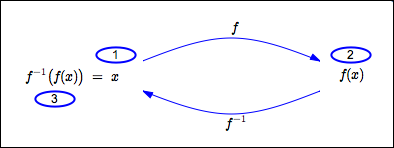 Properties of Inverse Functions
Properties of Inverse Functions
This lesson will be more accessible if you fully understand the concepts in these prior lessons:
- Using a Function Box ‘Backwards’
- One-to-One Functions
- Undoing a One-to-One Function; Inverse Functions
Every one-to-one function $\,f\,$ has an inverse. This inverse is denoted by $\,f^{-1}\,$ and read aloud as ‘$\,f\,$ inverse’.
A function and its inverse ‘undo’ each other: one function does something, the other undoes it. The purpose of this lesson is to make this idea precise.
Review: Domain and Range of a Function
The set of allowable inputs for a function $\,f\,$ is called its domain, and is denoted by $\,\text{dom}(f)\,.$
The set of all possible outputs from a function $\,f\,$ is called its range, and is denoted by $\,\text{ran}(f)\,.$ That is, let $\,f\,$ act on every possible input—every element of its domain. The set of resulting outputs is the range of $\,f\,$:
$$\cssId{s19}{\text{ran}(f)} \cssId{s20}{= \{ f(x)\ |\ x\in\text{dom}(f) \}} $$The Functions $\,f\,$ and $\,f^{-1}\,$ ‘Undo’ Each Other

- Start with an allowable input for $\,f\,.$ That is, let $\,x\in\text{dom}(f)\,.$
- Let $\,f\,$ act on $\,x\,,$ giving $\,f(x)\,.$
- Let $\,f^{-1}\,$ act on $\,f(x)\,,$ giving $\,f^{-1}(f(x))\,.$
This returns us to where we started, so:
$\,f^{-1}(f(x)) = x\,$ for all $\,x\,$ in the domain of $\,f\,$
In other words, the composite function $\,f^{-1}\circ f\,$ is the identity function on $\,\text{dom}(f)\,.$

- Start with an output from $\,f\,.$ That is, let $\,y\in\text{ran}(f)\,.$
- Let $\,f^{-1}\,$ act on $\,y\,,$ giving $\,f^{-1}(y)\,.$
- Let $\,f\,$ act on $\,f^{-1}(y)\,,$ giving $\,f\bigl(f^{-1}(y)\bigr)\,.$
This returns us to where we started, so:
$\,f\bigl(f^{-1}(y)\bigr) = y\,$ for all $\,y\,$ in the range of $\,f\,$
In other words, the composite function $\,f\circ f^{-1}\,$ is the identity function on $\,\text{ran}(f)\,.$
Input/Output Roles Reversed for $\,f\,$ and $\,f^{-1}\,$
The input/output roles for a function and its inverse are reversed—the inputs to one are the outputs from the other. This fact has some nice consequences:
Points on the Graphs of $\,f\,$ and $\,f^{-1}\,$ Have Their Coordinates Switched
$\,(a,b)\,$ is on the graph of $\,f\,$
if and only if
$\,(b,a)\,$ is on the graph of $\,f^{-1}\,$
Domain and Range of $\,f^{-1}$
- The inputs to $\,f^{-1}\,$ are the outputs from $\,f\,.$ That is, $\,\text{dom}(f^{-1}) = \text{ran}(f)\,.$
- The outputs from $\,f^{-1}\,$ are the inputs to $\,f\,.$ That is, $\,\text{ran}(f^{-1}) = \text{dom}(f)\,.$
Summary: Properties of Inverse Functions
For your convenience, the properties of inverse functions discussed in this and earlier exercises are summarized below.
A function $\,g\,$ has an inverse if and only if $\,g\,$ is a one-to-one function.
Let $\,f\,$ be a one-to-one function. The inverse of $\,f\,$ is denoted by $\,f^{-1}\,$ and read aloud as ‘$\,f\,$ inverse’.
The functions $\,f\,$ and $\,f^{-1}\,$ satisfy the following properties:
- $\,f^{-1}\,$ is also a one-to-one function
- the inverse of $\,f^{-1}\,$ is $\,f\,$
- $\,f(x) = y\,$ if and only if $\,f^{-1}(y) = x$
- $\,f^{-1}(f(x)) = x\,$ for all $\,x\in\text{dom}(f)$
- $\,f\bigl(f^{-1}(y)\bigr) = y\,$ for all $\,y\in\text{ran}(f)$
- $(a,b)$ is on the graph of $\,f\,$ if and only if $\,(b,a)\,$ is on the graph of $\,f^{-1}$
- $\text{dom}(f^{-1}) = \text{ran}(f)\,$ and $\text{ran}(f^{-1}) = \text{dom}(f)$